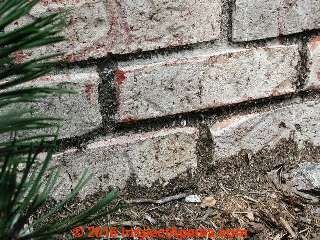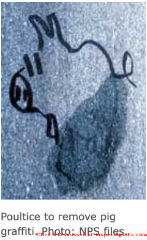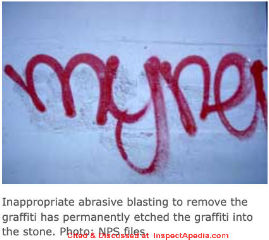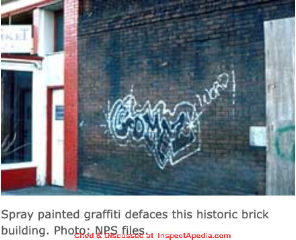 How to Remove Graffiti
How to Remove Graffiti
from brick, concrete, concrete block, stone & similar masonry surfaces
- POST a QUESTION or COMMENT about removing graffiti from masonry surfaces
Graffiti removal: advice & procedures from experts.
This article series describes the causes & cures for various types of stains found on concrete, stone & masonry surfaces both outdoors and indoors.
The article series also distinguishes among common brick stain sources such as algae, bacteria, lichens, moss, soot, sulphur, fungal growth, and other causes of markings on brick.
InspectAPedia tolerates no conflicts of interest. We have no relationship with advertisers, products, or services discussed at this website.
- Daniel Friedman, Publisher/Editor/Author - See WHO ARE WE?
Graffiti Removal Procedures
The table below is adapted from an older US NPS document, providing a detailed list of graffiti removal suggestions not present in some later documents.
Suggestions for Removing Graffiti from Historic Masonry |
||
| Graffiti Media | Removal Method | Health & Safety Warnings |
| Ballpoint Pen | 1. Erase with non-abrasive pencil eraser. 2. Poultice with organic solvent or petroleum-based compound**. 3. Wash with water and non-ionic detergent. 4. Rinse with water. |
+ See cautions below for NMP, solvents and petroleum-based compounds. Wear proper respirator, gloves and eye protection. |
| Chalk/ Pastel (Not wax or oil based) |
1. Brush off with bristle brush. 2. Wash with water and non-ionic detergent. 3. Rinse with water. |
None. |
| Crayon Lipstick Shoe Polish |
1. Poultice with denatured alcohol, paint remover* or organic solvent**. 2. Wash with water and non-ionic detergent. 3. Rinse with water . |
+ See cautions below for NMP, solvents and petroleum-based compounds. Wear proper respirator, gloves and eye protection. |
| Paint Spray (aerosol) Non-spray paint |
1. Poultice with paint remover*, organic solvent, or petroleum-based compound**. 2. Rinse with water, denatured alcohol or mineral spirits. 3. Wash with water and non-ionic detergent. 4. Rinse with water. |
+ See cautions below for NMP, solvents and petroleum-based compounds. Wear proper respirator, gloves and eye protection. |
| Pencil | 1. Erase with non-abrasive pencil eraser. 2. Wash with water and non-ionic detergent. 3. Rinse with water. |
None. |
| Permanent (felt-tip) Marker | 1. Wash with water and non-ionic detergent, if necessary. 2. Poultice with bleach***, paint remover*, organic solvent or petroleum-based compound**. 3. Wash with water and non-ionic detergent 4. Rinse with water. |
+ See cautions below for NMP, solvents and petroleum-based compounds. Bleach is corrosive, causes chemical burns and forms toxic gases (chlorine) Wear proper respirator, gloves and eye protection. |
| Water soluble (felt tip) Marker | 1. Wash with water and non-ionic detergent. 2. Poultice with bleach***. 3. Wash with water and non-ionic detergent. 4. Rinse with water. |
Bleach is corrosive, causes chemical burns and forms toxic gases (chlorine) Wear proper respirator, gloves and eye protection. |
Notes to the table above
- Watch out: These are suggestions to assist in graffiti removal.
Graffiti removal methods should always be tested first under the supervision and guidance of an architectural conservator - Notes keyed to the table above:
* Paint Remover based on N-methyl-2-pyrrolidone (NMP).
** Organic Solvent such as acetone, lacquer-thinner, or petroleum-based compound such as dimethyl adipate.
*** Bleach such as calcium hypochlorite.
+ N-methyl-2-pyrrolidone (NMP) is mildly toxic and may have adverse reproductive effects.
Solvents and petroleum-based compounds have toxic vapors, are flammable, and require well-ventilated conditions.
Graffiti photos above are excerpted from Weaver (1995) cited in detail below and illustrate using a poultice as part of a graffiti removal procedure and inappropriate sand-blasting efforts to remove graffiti - a procedure against which readers are warned in this article series.
[Click to enlarge any image]
- Source: Weaver, Martin E., REMOVING GRAFFITI from HISTORIC MASONRY [PDF] (1995) Preservation Brief No. 38, US NPS (cited in detail below)
Excerpt:
Summary
Although rapid graffiti removal is the most effective weapon in eliminating graffiti and preventing its recurrence in the same location, hasty, untested removal attempts can disfigure and cause harm to historic masonry.
Thus, it is important that the owner or manager of a historic masonry building or structure be prepared with a plan to ensure the prompt removal of graffiti when it occurs.
Regularly scheduled maintenance and cleaning programs to eliminate graffiti from historic masonry properties may be assisted by the installation of physical barriers, security systems and lighting, as well as increased community involvement.
Successful graffiti removal from historic masonry requires knowledge of a variety of cleaning methods and materials, and an awareness that what works to remove graffiti from one kind of masonry surface may not remove it from another.
By testing different cleaning methods in advance, treatment plans will be available, when needed, to provide guidance for safe and sensitive graffiti removal from historic masonry.
Graffiti Removal Guides
Graffiti photo from Weaver (1995) cited in detail, below.
- Ashurst, Nicola. Cleaning Historic Buildings. Vol. I: Substrates, Soiling and Investigations; Vol. II: Cleaning Materials and Processes. London: Donhead Publishing Ltd., 1994.
- Brick Industry Association (BIA), CLEANING BRICKWORK [PDF] in Technical Notes on Brick Construction, August 2018, BIA 12007 Sunrise Valley Drive, Suite 430, Reston, Virginia 20191 USA retrieved 2019/08/16, original source: http://www.gobrick.com/docs/default-source/read-research-documents/technicalnotes/20-cleaning-brickwork.pdf www.gobrick.com | 703-620-0010
- Ehrenkrantz & Eckstut Architects, P.C Technical Tips:
Removing Graffiti. New York: New York Landmarks
Conservancy, n.d. (1994).
- Grimmer, Anne E. DANGERS OF ABRASIVE CLEANING TO HISTORIC BUILDINGS [PDF] (1979) [Department of the Interior], Heritage Conservation and Recreation Service [Office of Archeology and Historic Preservation], Technical Preservation Services Division, 1979.
- Grimmer, Anne E. KEEPING IT CLEAN: REMOVING EXTERIOR DIRT, PAINT, STAINS AND GRAFFITI FROM HISTORIC MASONRY BUILDINGS [PDF] Washington, D.C.: Preservation Assistance Division, National Park Service, U.S. Department of the Interior, 1988. - retrieved 2022/10/08, original source: https://www.nps.gov/tps/how-to-preserve/preservedocs/Keeping-It-Clean.pdf
Excerpt:
The purpose of this technical report is to provide information on removing dirt, stains, paint and related coatings, graffiti, and other disfiguring or potentially harmful substances from exterior masonry. - Heidelmann, Hendrik. "Voruntersuchungen zum Zustand der Architekturteile und des plastischen Zierats des Sandsteinbaus der Kunstakademie Dresden." Arbeitsblätter für Restauratoren. Gruppe 6. Stein 27, no. 2, Gruppe 6 (1994): 313-318.
- Hocken, Jörg, and Bernd Proft. "Clean surfaces by utilization of the photocatalytic effect." (2003).
- Liu, Katherine, and Elsa Garmire. "Paint removal using lasers." Applied optics 34, no. 21 (1995): 4409-4415.
- Mack, Robert C., FAIA & Anne E. Grimmer, ASSESSING CLEANING AND WATER-REPELLENT TREATMENTS FOR HISTORIC MASONRY BUILDINGS [PDF] (2000) U.S. National Park Service, Technical Preservation Services, retrieved 2022/10/02 original source: https://www.nps.gov/tps/how-to-preserve/briefs/1-cleaning-water-repellent.htm
- Reisner, Robert. Graffiti: Two Thousand Years of Wall Writing. Chicago: Cowles Book Company, 1971.
- RI, Graffiti Removal Manual. Providence, RI: Keep Providence Beautiful, September 1986.
- Rozniakowski, Kazimierz, Piotr Klemm, and Agnieszka J. Klemm. "Some experimental results of laser beam interaction with surface layer of brick." Building and Environment 36, no. 4 (2001): 485-491.
- US GSA REMOVING DIRT from BRICK MASONRY [PDF] U.S. General Services Administration, retrieved 2020/12/14
- US GSA CHEMICALLY REMOVING PAINT FROM and REPAINTING BRICK MASONRY [PDF] U.S. General Services Administration, retrieved 2020/12/14
Excerpt:
This procedure includes guidance on chemically removing paint from and repainting brick masonry.
NOTE: Sandblasting is not recommended by the secretary of the interior's standards for rehabilitation and shall not be used. High-pressure water blasting is also not recommended without adequate testing or experience as it may erode soft brick and drive moisture into the wall. - US GSA GENERAL CLEANING of EXTERIOR BRICK MASONRY [PDF] U.S. General Services Administration, retrieved 2020/12/14
- U.S. GSA REMOVING PAINTED GRAFFITI FROM MASONRY [PDF] (2018) U.S. General Services Administration, retrieved 2020/12/14
Excerpt:
This procedure includes guidance on removing painted graffiti from historic masonry (this includes spray paint and paint-based felt-tipped markers).
Successful removal of graffiti from masonry is dependent upon the type and surface texture of the masonry as well as the particular substance applied. - VanGo, from ATCO International, 1401 Barclay Circle, SE Marietta, Georgia 30060-2925 produces a series of cleaners and paint and graffiti removers. 1-800-723-2826 Website: https://www.atcointernational.com/prod-22-1-663-24/vango-ii.htm
- Weaver, Martin E., REMOVING GRAFFITI FROM HISTORIC MASONRY [PDF] (1995) Preservation Brief 38, US National Park Service, retrieved 2022/06/30 original source: https://www.nps.gov/tps/how-to-preserve/briefs/38-remove-graffiti.htm saved as updated PDF in latest, color version by InspectApedia
- Weaver, Martin E., REMOVING GRAFFITI from HISTORIC MASONRY - COMPLETE [PDF] (1995) Preservation Brief No. 38, US NPS, retrieved 2022/10/09, original source: https://www.nps.gov/tps/how-to-preserve/preservedocs/preservation-briefs/38Preserve-Brief-Graffiti.pdf
Excerpts:
Removing graffiti as soon as it appears is the key to its elimination-and recurrence.
Thus, the intent of this Preservation Brief is to help owners and managers of historic masonry structures find the best way to remove exterior, surface-applied graffiti* quickly, effectively, and safely.
The Brief will discuss the variety of materials used to apply graffiti, and offer guidance on how to remove graffiti from all types of historic masonry without harming either the surface or the substrate.
Suggestions will also be given regarding the use of physical barriers to protect masonry surfaces from graffiti, and the application of barrier coatings to facilitate graffiti removal.
Building managers and owners of historic properties will be advised on the importance of being prepared for rapid graffiti removal by testing different cleaning techniques in advance in order to select the most appropriate and sensitive cleaning technique. Health and safety and environmental concerns are addressed, as well as regulatory matters.
Removing graffiti without causing damage to historic masonry is a job for trained maintenance crews, and in some cases, professional conservators, and generally should not be attempted by untrained workers, property owners or building managers.
Although the focus of this Preservation Brief is on historic masonry, the same guidance may be applied equally to removing graffiti from non-historic masonry.
Anne E. Grimmer, Senior Architectural Historian, Technical Preservation Services, Preservation Assistance Division, National Park Service, coordinated the development of this Preservation Brief and served as Technical Editor. - Whitford, Maurice J. Getting Rid of Graffiti: A practical guide
to graffiti removal and anti-graffiti protection. New York: Van
Nostrand Reinhold, Inc., 1992.
...
Continue reading at BRICK SURFACE PAINT REMOVAL, or select a topic from the closely-related articles below, or see the complete ARTICLE INDEX.
Or see these
Recommended Articles
- EFFLORESCENCE SALTS & WHITE DEPOSITS
- GRAFFITI REMOVAL FROM BRICK CONCRETE STONE SURFACES
- MASONRY CLEANERS
- STAIN DIAGNOSIS on BUILDING EXTERIORS - home
- STAINS on BRICK SURFACES
- STAINS on CONCRETE
- STAINS on INDOOR SURFACES, PHOTO GUIDE
- STAINS on SANDSTONE, DIAGNOSE & CURE
- STAINS on STONE, STUCCO DIAGNOSE & CURE
- STONE, STUCCO & BRICK CLEANING METHODS
- STONE SURFACE CLEANING & ORGANIC GROWTH PREVENTION (Algae, Fungus, Lichens, Moss) from Stone, Brick, or Concrete Surface
Suggested citation for this web page
GRAFFITI REMOVAL FROM BRICK CONCRETE STONE SURFACES at InspectApedia.com - online encyclopedia of building & environmental inspection, testing, diagnosis, repair, & problem prevention advice.
Or see this
INDEX to RELATED ARTICLES: ARTICLE INDEX to BUILDING STAINS
Or use the SEARCH BOX found below to Ask a Question or Search InspectApedia
Ask a Question or Search InspectApedia
Try the search box just below, or if you prefer, post a question or comment in the Comments box below and we will respond promptly.
Search the InspectApedia website
Note: appearance of your Comment below may be delayed: if your comment contains an image, photograph, web link, or text that looks to the software as if it might be a web link, your posting will appear after it has been approved by a moderator. Apologies for the delay.
Only one image can be added per comment but you can post as many comments, and therefore images, as you like.
You will not receive a notification when a response to your question has been posted.
Please bookmark this page to make it easy for you to check back for our response.
IF above you see "Comment Form is loading comments..." then COMMENT BOX - countable.ca / bawkbox.com IS NOT WORKING.
In any case you are welcome to send an email directly to us at InspectApedia.com at editor@inspectApedia.com
We'll reply to you directly. Please help us help you by noting, in your email, the URL of the InspectApedia page where you wanted to comment.
Citations & References
In addition to any citations in the article above, a full list is available on request.
- Grimm, Clayford T. "Don’t sandblast brick." The Magazine of Masonry Construction (1990): 115-116.
- Heidelmann, Hendrik. "Voruntersuchungen zum Zustand der Architekturteile und des plastischen Zierats des Sandsteinbaus der Kunstakademie Dresden." Arbeitsblätter für Restauratoren. Gruppe 6. Stein 27, no. 2, Gruppe 6 (1994): 313-318.
- Preston, John. "The surface restoration of buildings–An investment in the present as well as in the future." Structural Survey 7, no. 4 (1989): 450-460.
- In addition to citations & references found in this article, see the research citations given at the end of the related articles found at our suggested
CONTINUE READING or RECOMMENDED ARTICLES.
- Carson, Dunlop & Associates Ltd., 120 Carlton Street Suite 407, Toronto ON M5A 4K2. Tel: (416) 964-9415 1-800-268-7070 Email: info@carsondunlop.com. Alan Carson is a past president of ASHI, the American Society of Home Inspectors.
Thanks to Alan Carson and Bob Dunlop, for permission for InspectAPedia to use text excerpts from The HOME REFERENCE BOOK - the Encyclopedia of Homes and to use illustrations from The ILLUSTRATED HOME .
Carson Dunlop Associates provides extensive home inspection education and report writing material. In gratitude we provide links to tsome Carson Dunlop Associates products and services.


 ...
... 
